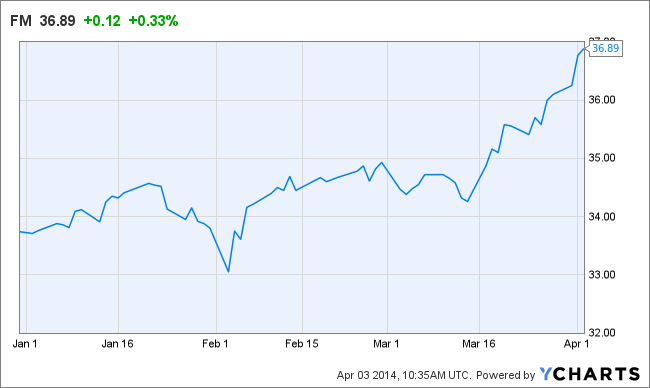After getting crushed during the early weeks of 2014, emerging market investors are finally seeing some glimmers of hope. Stock and bond markets are recovering in many parts of the developing world as the second quarter unfolds.
On top of that, there are tentative signs portfolio money is returning to these markets, suggesting possibly more gains ahead. The iShares MSCI Emerging Markets ETF (EEM) is up more than 7% since March 19.
Other emerging market ETFs have also rebounded since mid-March. The PowerShares India Portfolio (PIN) is up 8%; the iShares MSCI Brazil Capped (EWZ) and iShares MSCI Russia Capped (ERUS) funds have advanced more than 11%. Meanwhile, the iShares MSCI Turkey ETF (TUR) is up more than 14%.
What’s behind the comeback? Easing tensions and the start of diplomatic talks between the U.S. and Russia about Ukraine seem to have helped. So have comments from Federal Reserve Chair Janet Yellen that monetary conditions in the U.S. will remain tame for some time to come.
Finally, emerging market stocks may have been beaten down so far that there could be bargains to be had. As Michael Krause, chief analyst at ETF-focused Altavista Research, told CNBC: “Emerging markets in general have been sold off hard over the last six months. On a valuation basis, they are as cheap as they were during the global financial crisis.”
Of course, cheap asset classes can always get cheaper. But some investors are looking for a rotation to emerging markets after trailing the U.S. and some other developed markets for so long.
In the last week of March, Bloomberg notes, emerging markets drew the largest investment flows among U.S. exchange-traded funds. Some $1.6 billion on a net basis headed into ETFs focused on emerging-market equities and bonds in the five days through March 28, helping chip away at the $12 billion culmulative outflow this year.
In emerging market equity funds, the recent heavy outflows “all but ceased” in the latest weekly data, Reuters reports.
“Dedicated emerging equity funds saw outflows of just $0.05 billion globally in the week to March 26,” according to the report. “Technically the tiny change notched up a 22nd straight week of losses but it marked a major turnaround from investors which have yanked around $40 billion out of emerging markets so far this year.”
Meanwhile, bond markets in many hard hit economies in Europe are looking up. Government bond yields from the Eurozone peripheral nations of Greece to Ireland (not technically emerging nations but definitely high-risk, high-return markets) are at the lowest level since 2010 as the recovery from the sovereign-debt crisis gains momentum.
There are also potential opportunities in frontier markets. Morningstar analyst Patricia Oey recently published an interesting post on investing in Africa, a vast market with great potential for investors with a tolerance for risk. She suggests the iShares MSCI South Africa Index (EZA) as kind of an all-in-one proxy play for the continent.
Oey also notes the fund holds “primarily well-run financial services, telecom, and consumer firms, many of which have operations across different African markets.”
ETFs focused on newly developing markets are performing well. The iShares MSCI Frontier 100 (FM) rose about 7% percent in the first quarter.
Covestor manager Charles Sizemore, who oversees the Tactical ETF and and Sizemore Global Macro portfolios on the Covestor platform, saw signs of the emerging market turnaround back on March 9. Sizemore said back then he also sees a rebound in Chinese equities this year.
Photo credit: Francisco Aragao via Flickr Creative Commons
DISCLAIMER: The investments discussed are held in client accounts as of March 31st, 2013. These investments may or may not be currently held in client accounts.The information in this material is not intended to be personalized financial advice and should not be solely relied on for making financial decisions. All investments involve risk, the amount of which may vary significantly. Past performance is no guarantee of future results.





